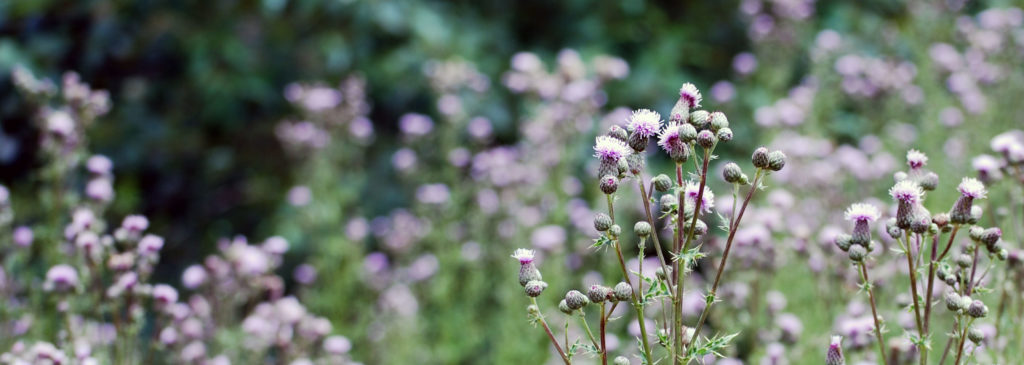Canada thistle (Cirsium arvense) is a widespread invasive weed found in all parts of Clackamas County. Unlike the many native thistles found in Oregon, Canada thistle can quickly overrun an area and displace native plants, reduce agricultural yield, and create problems for grazing animals when they infest a field or pasture. They also cost a lot of money and time to control.
Also known as Canadian thistle, corn thistle, or creeping thistle, Canada thistle can be found in disturbed areas that have abundant sun and moist soils. It is found in crop fields, forest openings, gardens, hillsides, logged areas, pastures, rangeland, roadsides, stream banks, and vacant lots.
How Can I Identify Canada Thistle?
When Canada thistle blooms, it creates clusters of pink to purple, bristly flowers that are approximately 1/2 inch long and wide. Thistle seeds are disbursed by wind and can survive in the soil for up to 20 years. Most new Canada thistle plants, however, sprout up from the lateral root systems of former and existing plants. These root systems can extend as far as six feet deep, and, in a single season, can spread horizontally up to 20 feet. Additionally, this noxious weed can quickly and easily reproduce from root fragments as small as a one-quarter inch long. Tillage and other cultivation methods can quickly spread a small infestation throughout an entire field.
Why Should I Care About Canada Thistle?
Like many noxious weeds in Clackamas County, Canada thistle invades a wide variety of habitats including natural areas and forest clearings. It can displace the native vegetation needed by wildlife for food and shelter. It reduces pasture forage for grazing animals and complicates reforestation and landscape restoration efforts. Management of Canada thistle costs cities, counties, and state agencies hundreds of thousands of dollars each year.
How Can I Control Canada Thistle?
As noted above, traditional cultural and mechanical controls are not effective in treating Canada thistle. Two biological controls, the Canada thistle gall-fly, and a stem-mining weevil have had very limited success in field settings and are ineffective overall.
The key to Canada thistle control is to stress the plant and force it to use its stored root nutrients. Mowing and hand-cutting can be used on small infestation before flowering to prevent the plant from producing seeds but must be repeated regularly throughout the growing season to suppress regrowth.
Foliar herbicides that mobilize their active ingredients into the root system of the plan are the most effective management for killing large stands of Canada thistle.
Regardless of the control method employed, returning infested land to a productive state occurs only over time and requires a sound management plan implemented over several years.
Because Canada thistle is so widespread, property owners in Clackamas County are not required to report infestation. We can help provide advice on how to best control Canada thistle. Contact the WeedWise program today!
Learn More!
For more information on Canada thistle control, check out the Oregon Department of Agriculture Weed Profile for Canada thistle.
